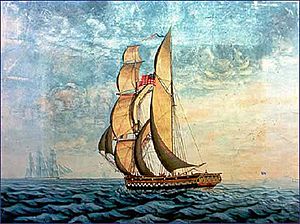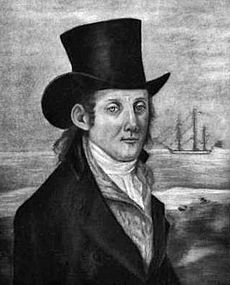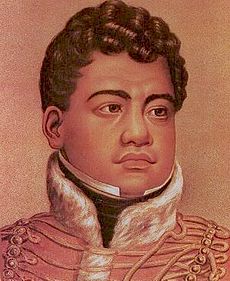Cleopatra's Barge facts for kids

1818 painting by George Ropes in Peabody Essex Museum
|
|
Quick facts for kids History |
|
|---|---|
| Name | Cleopatra's Barge |
| Owner | George Crowninshield Jr. |
| Builder |
|
| Cost | $100,000 (including furnishings) |
| Launched | October 21, 1816 |
| Completed | December 1816 |
| Out of service | November 1817 |
| Acquired | November 16, 1820 |
| Renamed |
|
| Fate | Wrecked 1824 |
| General characteristics | |
| Tons burthen | 192 tons bm |
| Length |
|
| Beam | 23 ft (7.0 m) |
| Draught | 11 ft (3.4 m) |
| Propulsion | Sails |
| Sail plan | Hermaphrodite brig |
The Cleopatra's Barge was a very special ship. It was the first "yacht" built in the United States. A yacht is a boat built just for fun and pleasure, not for carrying goods or fighting.
This amazing ship was built in 1816 in Salem, Massachusetts. It was made by a shipbuilder named Retire Becket for its owner, George Crowninshield Jr.. He loved his ship and took it on a big trip across the ocean.
After Crowninshield passed away, the ship was sold. It ended up in Hawaii, where the king, Kamehameha II, bought it. He renamed it Haʻaheo o Hawaiʻi (which means "Pride of Hawaii"). Sadly, the ship was wrecked in 1824.
Contents
Building a Unique Ship: Cleopatra's Barge
Why Was Cleopatra's Barge So Special?
In the 1700s, the Crowninshield family in Salem, Massachusetts had a very successful shipping business. During wars, their merchant ships were sometimes used as privateers. These were private ships that attacked enemy ships. The family earned a lot of money this way.
George Crowninshield Jr. decided to build a ship just for fun. This was very unusual at the time. Most American ships were for trade or for the navy. He first called his new ship Car of Concordia. But he later changed the name to Cleopatra's Barge. He named it after the famous Egyptian Queen Cleopatra VII's beautiful boat.
How Was Cleopatra's Barge Designed?
The ship was built by Retire Becket and launched on October 21, 1816. It was about 25 meters (83 feet) long at the waterline and 7 meters (23 feet) wide. It had two masts, like a hermaphrodite brig. This design made it fast and easy to sail with a small crew.
Building the ship cost about $50,000. Another $50,000 was spent on fancy decorations and furniture. The main room was covered in shiny mahogany wood. The furniture was made of red velvet with gold trim. Even the kitchen had special silver, china, and glassware. One side of the ship was painted with colorful stripes, and the other had a zig-zag pattern. It even had indoor plumbing!
Public Tours and Winter Freeze
On December 6, 1816, the ship was opened for public tours. Thousands of people came to see this amazing new yacht. After a short test sail, a very cold winter froze the ship into the dock. It stayed there until the ice melted.
The Salem Gazette newspaper wrote about the ship in January 1817. They said that Mr. Crowninshield's beautiful ship, built for a fun trip, was completely new in America. It made everyone curious and amazed.
Crossing the Atlantic: A Grand Voyage
First American Pleasure Trip Across the Ocean
On March 30, 1817, Cleopatra's Barge began its journey. It was the first American ship built just for pleasure to sail across the Atlantic Ocean. George Crowninshield Jr.'s brother, Benjamin Williams Crowninshield, was the Secretary of the Navy. He helped get important letters for the trip.
An older cousin, Benjamin Crowninshield, was the ship's captain. He had been a brave officer on privateer ships during earlier wars. His son, Benjamin Crowninshield Jr., kept a detailed logbook of the journey. It included sketches and watercolors.
Visiting Europe and Meeting Important People
During a six-month trip around the Mediterranean Sea, huge crowds came to see the yacht. Sometimes as many as 8,000 people would visit at each port.
They visited many places, including:
- Faial Island in the Azores, where the American Consul held a party for them.
- Funchal on Madeira.
- Gibraltar.
- Ports along the southern coast of Spain, like Málaga.
- Marseilles in France, where the ship was repainted.
- Toulon in France and Genoa in Italy, where they met a famous astronomer.
Rumors of a Secret Mission
Many people thought the Crowninshields were planning something secret. They believed the family wanted to help Emperor Napoléon Bonaparte escape from his exile on Saint Helena island.
There were many reasons for these rumors:
- The Crowninshields had a history with Napoleon.
- They visited Napoleon's supporters and relatives on the island of Elba.
- In Rome, they met Napoleon's mother and siblings.
- They even brought aboard Napoleon's doctor and souvenirs like his boots!
The ship was watched by French, British, and American navy ships, and even pirates. But Cleopatra's Barge was so fast that it outran them all. These informal races were like early yacht races! It was also rumored that George hoped to bring back a European princess to marry. But he returned without a wife or an emperor.
After returning to Salem on October 3, George Crowninshield Jr. sadly died suddenly on November 26, 1817. He was on board the ship, planning his next adventure. Some of the ship's beautiful furnishings were later put in the Peabody Essex Museum.
The Barge was sold to one of Crowninshield's brothers in 1818. He used it for a few trading trips. In 1820, two merchants from Boston, William Sturgis and John Bryant, bought the ship. They had a secret plan. They loaded the ship with cargo, making people think it was for trade. But Captain John Suter had instructions to sail it to the Kingdom of Hawaii and try to sell it there.
Journey to the Pacific: A Royal Purchase
Arriving in the Sandwich Islands
Before landing in Hawaii, the ship was cleaned and painted. Captain Suter had visited the Hawaiian Islands before. He was right to think the king would be interested. On November 6, 1820, the day after the ship arrived, King Kamehameha II (also known as Liholiho) came to inspect it. He was very impressed.
The ancient Hawaiians loved boats. The young king knew his father, Kamehameha the Great, had used large Western ships to help conquer the islands.
The King Buys His Yacht
On November 16, 1820, the price was agreed upon. The king would pay 8,000 piculs of sandalwood. This was over a million pounds of wood! It was worth about $80,000 at the time.
Kamehameha II was very proud of his new ship. Charles Bullard, who worked for the ship's sellers, said that the king "worships the Barge." This shows how much the king loved his new yacht.
Life on the Royal Yacht
Many people served as captains of the ship in Hawaii. These included the king's French secretary, Jean-Baptiste Rives, and Hawaiian leaders like Prime Minister Kalanimoku.
The yacht had cannons that were fired for special events. When it arrived in Honolulu at night, the loud blasts and flashes from the cannons caused a big stir. People were frightened, and dogs barked. It was a very memorable sight!
In July 1821, King Kamehameha II took a small boat for a short trip near Honolulu. But he decided to go all the way to the island of Kauaʻi, across a rough sea. His wives and chiefs followed him on the royal yacht. The king used the yacht to entertain the ruler of Kauaʻi, Kaumualiʻi. One night, Kamehameha II secretly sailed back to Oʻahu, taking Kaumualiʻi with him. This meant Kaumualiʻi was no longer ruler of Kauaʻi.
Russian visitors to the ship noticed an African servant. He offered guests a choice of drinks. This might have been William Chapman, who was the yacht's cook for the Crowninshields. He was said to be an expert at navigating ships.
Rebuilding and Renaming the Ship
By April 1822, much of the ship's wood was rotting. Some historians think the sellers knew about this and wanted to sell it quickly. The king threatened to stop paying for the ship.
The ship was taken out of the water and rebuilt. Captain Thomas Meek was hired to replace the rotting wood. He traveled to the Pacific Northwest to get new lumber. He finished the work in the spring of 1823. On May 10, 1823, the ship was launched again. It was renamed Haʻaheo o Hawaiʻi, meaning "Pride of Hawaii."
The royal court and missionaries often sailed on the yacht between islands. Missionaries even held services on board, saying the ship's acoustics were great for hymns.
In November 1823, Kamehameha II decided to visit the King of Great Britain. They used a whaling ship for the trip because its crew knew the route better. Sadly, Kamehameha II passed away in Britain and never saw his yacht again.
The Final Journey: Wrecked in Hanalei Bay
On April 6, 1824, the Haʻaheo o Hawaiʻi ran aground on a shallow reef in Hanalei Bay, on Kauaʻi island. Some believe the ship was scouting for a possible rebellion. Others blamed the crew.
The Hawaiians tried to save the ship. They made three huge ropes from local plants. They tied them to the ship's main mast and tried to pull the ship upright. They sang together as they pulled, and the ship started to move. But then the mast snapped, and the ropes fell into the sea.
Before they could try again, news came that Kaumualiʻi was dying. The people of Kauaʻi left. After taking any useful parts from the ship, the wreck was left to be broken up by the ocean waves.
Recovery and Future Plans
Over the years, parts of the ship have been found. A piece of the hull washed ashore in 1844. Two cannons were found in 1857. Tsunamis and even a hurricane in 1992 likely spread the wreckage around.
In 1994, Paul Forsythe Johnston from the Smithsonian Institution began searching for the wreck. He used a special research vessel with a proton magnetometer to find metal objects underwater. After several years, the ship's remains were finally located. Many artifacts were carefully dug up and studied. A part of the stern (the back of the ship) was uncovered, documented, and then re-buried to protect it.
In 2008, someone suggested building a replica of the ship. It was estimated that it would cost over $7 million to build a new Cleopatra's Barge.
Images for kids
-
1818 painting by George Ropes in Peabody Essex Museum








